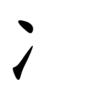See also: 氷,
氵,
ソ,
ン,
疒, and 仌
Translingual[edit]
| Stroke order
|

|
Han character[edit]
冫 (Kangxi radical 15, 冫+0, 2 strokes, cangjie input 戈一 (IM), four-corner 30100, composition ⿱丶㇀)
- Kangxi radical #15, ⼎.
Derived characters[edit]
- Appendix:Chinese radical/冫
- 丬, 次, 𪟅, 飡, 馮, 𧩏, 𩇝, 𩇟, 𣱖, 𧗠, 氺, 疒, 兆, 习, 㭍, 𫝓, 㞑, 弱, 率
References[edit]
- Kangxi Dictionary: page 131, character 15
- Dai Kanwa Jiten: character 1607
- Dae Jaweon: page 294, character 11
- Hanyu Da Zidian (first edition): volume 1, page 295, character 1
- Unihan data for U+51AB
Chinese[edit]
Glyph origin[edit]
|
|
Old Chinese
|
| 冫
|
*prɯŋ
|
| 冰
|
*pŋrɯŋ, *ŋrɯŋ
|
| 砅
|
*pʰrɯŋ, *rads
|
| 馮
|
*brɯŋ, *bɯŋ
|
| 憑
|
*bɯŋ
|
Radical form of 仌.
Pronunciation[edit]
| Baxter–Sagart system 1.1 (2014)
|
| Character
|
冫
|
| Reading #
|
1/1
|
Modern
Beijing
(Pinyin)
|
bīng
|
Middle
Chinese
|
‹ ping ›
|
Old
Chinese
|
/*p.rəŋ/ (dialect: *p.r- > *pr-)
|
| English
|
ice
|
Notes for Old Chinese notations in the Baxter–Sagart system:
* Parentheses "()" indicate uncertain presence;
* Square brackets "[]" indicate uncertain identity, e.g. *[t] as coda may in fact be *-t or *-p;
* Angle brackets "<>" indicate infix;
* Hyphen "-" indicates morpheme boundary;
* Period "." indicates syllable boundary.
|
| Zhengzhang system (2003)
|
| Character
|
冫
|
| Reading #
|
1/1
|
| No.
|
855
|
Phonetic
component
|
仌
|
Rime
group
|
蒸
|
Rime
subdivision
|
0
|
Corresponding
MC rime
|
冫
|
Old
Chinese
|
/*prɯŋ/
|
Definitions[edit]
冫
- Radical form of 仌.
Usage notes[edit]
- This radical is also referred as 兩點水/两点水 (liǎngdiǎnshuǐ) or 冰字旁 (bīngzìpáng).
Japanese[edit]
冫
(uncommon “Hyōgai” kanji)
- “ice” radical (二水, nisui)
Readings[edit]
Usage notes[edit]
Appears only as a radical.
冫 (eumhun 얼음 빙 (eoreum bing))
Definition: pure ice/water of which 빙 derives from the modern Beijing pronunciation of 水
Vietnamese[edit]
Han character[edit]
冫: Hán Nôm readings: băng
- This term needs a translation to English. Please help out and add a translation, then remove the text
{{rfdef}}.
References[edit]





